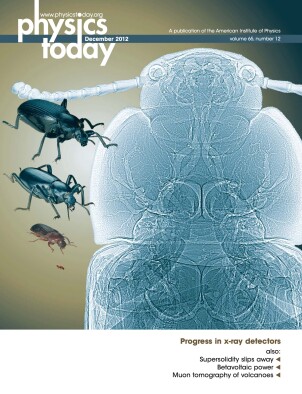Temperature-sensitive colloids show off an elusive melting mechanism
DOI: 10.1063/PT.3.1810
It’s been known for decades that colloids form ordered crystalline phases when packed together closely enough; when given more room to move, they behave like liquids. Colloidal systems thus offer a model for the microscopic mechanisms of phase transitions—processes that can’t be directly observed in normal crystals because molecules are too small and move too fast (see Physics Today, December 1998, page 24
In 2005 Arjun Yodh and colleagues at the University of Pennsylvania overcame that difficulty: They devised micron-sized polymer particles that reversibly shrink when heated, so the volume fraction can be tuned above and below the phase-transition threshold. 1 Yodh’s team used the particles to study heterogeneous melting, which begins at a grain boundary or other defect. Heterogeneous melting at a liquid–solid interface—the familiar case of an ice cube melting in a glass of water—had been studied and its mechanism understood: Particles near the surface begin to lose their crystalline order before the bulk material reaches its melting point. Yodh and colleagues were the first to observe the same mechanism at the interface between two crystalline domains.
Now Yilong Han and his colleagues at the Hong Kong University of Science and Technology have used the heat-sensitive particles to study the poorly understood process of homogeneous melting, in which a perfect crystal melts via the spontaneous nucleation of small liquid regions far from any preexisting defect or interface. 2 Because surface tension and strain between liquid and crystal compete with the bulk material’s free energy, a liquid nucleus is stable only when it’s larger than some critical size. Smaller nuclei just recrystallize—even when the bulk melting point is exceeded—so the crystal becomes superheated. Superheating and homogeneous melting are known to occur when a single crystal is heated internally with a laser or when surface melting is suppressed. But the nucleation mechanism has never before been observed experimentally, and computer simulations have yielded inconsistent results.
Han and company superheated a colloidal crystal—that is, they reduced the volume fraction below that which would normally trigger melting. Then they held it at constant temperature and watched it evolve. Snapshots from one of the 200 melting transitions they studied are shown in the figure. Blue, green, and orange dots represent solid-phase particles with progressively greater deviations from their lattice positions; liquid-phase regions, defined by a large deviation from hexagonal symmetry between a particle and its nearest neighbors, are shown in red. The researchers found that melting began not with the spontaneous formation of crystal defects, as some computer simulations had predicted, but rather with so-called loop rearrangements, first predicted by Xian-Ming Bai and Mo Li, 3 in which particles swapped places while leaving the crystal structure intact.

What happened next depended on the degree of superheating. In weakly superheated crystals, liquid nuclei appeared and recrystallized until, by chance, one formed that was large enough to grow and melt the entire crystal. In more strongly superheated samples, two or more subcritical nuclei that formed near each other often coalesced into a nucleus of the critical size. At even more extreme superheating—when the volume fraction was reduced some 20% below the critical value for the melting transition—the crystalline phase was no longer metastable, and the entire crystal melted catastrophically.
References
1. A. M. Alsayed et al., Science 309, 1207 (2005). https://doi.org/10.1126/science.1112399
2. Z. Wang et al., Science 338, 87 (2012). https://doi.org/10.1126/science.1224763
3. X.-M. Bai, M. Li, Phys. Rev. B 77, 134109 (2008). https://doi.org/10.1103/PhysRevB.77.134109
